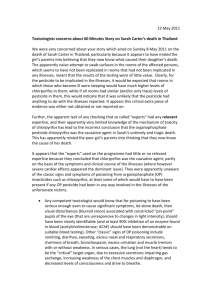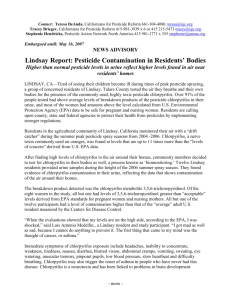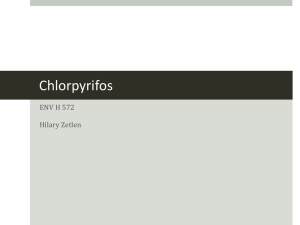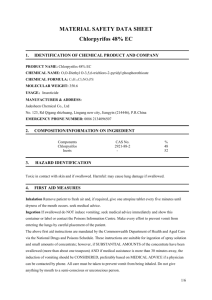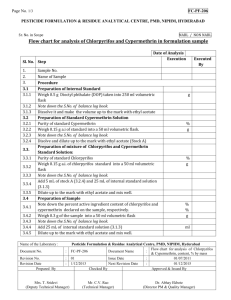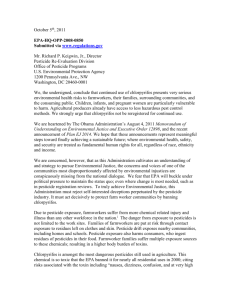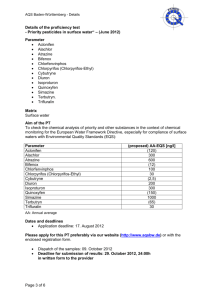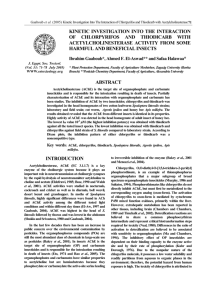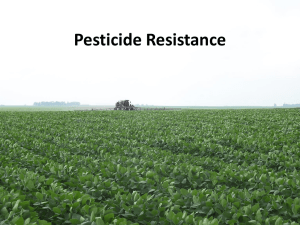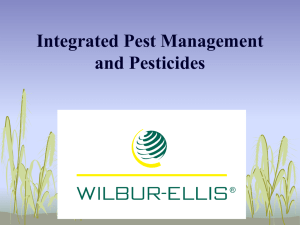20121009-belgrade-chlorpyrifos
advertisement
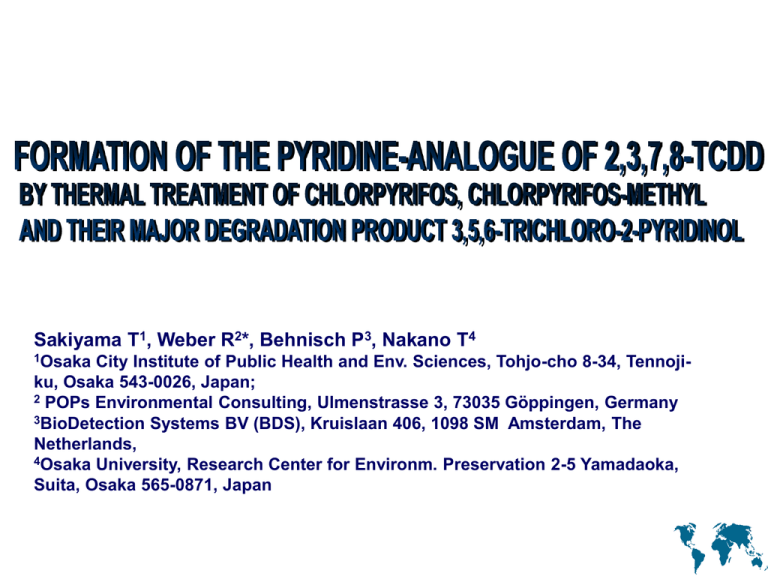
Sakiyama T1, Weber R2*, Behnisch P3, Nakano T4 1Osaka City Institute of Public Health and Env. Sciences, Tohjo-cho 8-34, Tennojiku, Osaka 543-0026, Japan; 2 POPs Environmental Consulting, Ulmenstrasse 3, 73035 Göppingen, Germany 3BioDetection Systems BV (BDS), Kruislaan 406, 1098 SM Amsterdam, The Netherlands, 4Osaka University, Research Center for Environm. Preservation 2-5 Yamadaoka, Suita, Osaka 565-0871, Japan Dioxins and pesticide history in Japan Dioxin and pesticide screening Australia (2010) 2,4,5-T and chlorpyrifos as Twins? Chlorpyrifos as Formation of Pyridin analogue 2,3,7.8-TCDD in thermal experiments Analytical behaviour of 2,3,7.8-TCDD-Py Dioxin-like toxicity of thermal experiments Possible practical experience 2,3,7.8-TCDD-Py Pesticide production, use and disposal have contributed significantly to polychlorinated dibenzo-p-dioxin and dibenzofuran (PCDD/F) emissions in the past. g TEQ/Jahr 70000 Masunaga et al. 1998 PCDD/PCDF in PCP PCDD/PCDF in CNP co-PCB Other Chlororganics Industrial Waste Incineration Municipal Waste Incineration 60000 50000 40000 30000 PCP IWI CNP 20000 10000 MWI co-PCB 0 1958 1963 1968 1973 1978 1983 1988 1993 DIOXIN IMPURITIES IN PESTICIDE FORMULATIONS Current use pesticide formulations Obsolete pesticide formulations 100,000 Formulation basis (FL) Active Ingredient basis (AI) Formulation basis (FL) (AI) Active Ingredient basis Concentration (ng TEQ kg-1) 10,000 1,000 100 10 1 0 Holt et al. ES&T. 44, 5409–5415 (2010) UNEP Emission Factor for 2,4,5-T In 2,4,5-T production and in product high 2,3,7,8-TCDD level Cl OR Cl O Cl Cl Cl Cl O Cl O Cl 2,4,5-Trichlorphenol (R=H) 2,4,5-T (R=Essigsäure) Cl Cl N 2,3,7,8-TCDD (Seveso-Dioxin; in Agent Orange) OR Cl Cl Cl Chlorpyrifos (R=Phosphor acid ester) 3,5,6-trichloro-2-pyridinol (R=H) N O N Cl Production Thermal Stress 2,4,5-Trichlorophenol (R=H) 2,4,5-T (R=Acetic Acid) (in Agent Orange) 2,3,7,8-TCDD (Seveso Dioxin) Production? Thermal Stress? Chlorpyrifos (R=Phosphor acid ester) 3,5,6-trichloro-2-pyridinol (R=H) 2,3,7,8-TCDD-pyridin-analogue Highest sales of chlorpyrifos of all organophosphate pesticides worldwide, and the third among all pesticides. In 2010, the consumption of chlorpyrifos globally (converted into technical) reached 80,000 tonnes with CAGR of about 12% in the past five years (2005 to 2010). Chinese production capacity was 116,000 tonnes (2010). Chlorpyrifos Chlorpyrifos-Methyl In Vietnam about 37,000 tonnes of 2,4,5-T have been sprayed in total containing 366 kg TEQ to 1123 kg TEQ (Stellmann et al., Nature 422, 681-687 (2003) All pyrolysis experiments were carried out in sealed brown glass ampoules (10 ml; air) with about 2 mg of respective chemical chlorpyrifos, chlorpyrifos-methyl and the major degradation product of chlorpyrifos, 3,5,6-trichloro-2pyridinol (TCPy) at temperatures between 300ºC and 380ºC. Chlorpyrifos Chlorpyrifos-Methyl Analytical grade chlorpyrifos, TCPy (both Dr. Ehrenstorfer GmbH, Augsburg/Germany) and chlorpyrifos-methyl (Wako Pure Chemicals, Osaka/Japan) were used. Relative abundance of 2,3,7,8-TCDD-pyridine-analogues formed in thermal experiments (ampoule; air;15 min) 2378-TCDD-pyridineanalogue (1)* 2378-TCDD-pyridineanalogue (2)** 300ºC 340ºC 380ºC 300ºC 340ºC 380ºC chlorpyrifos 0 0 1x10^5 0 0 3x10^5 chlorpyrifosmethyl 0 0 6x10^5 0 0 3x10^6 3,5,6-trichloro-2pyridinol 1x10^5 6x10^6 3x10^7 1x10^5 1x10^7 1x10^8 *trans-isomer of 2,3,7,8-TCDD-Py; **cis-isomer of 2,3,7,8-TCDD-Py ① ⑤ ② ④ ③ Peak ⑤ Peak ① & Peak ③ Peak ② & Peak ④ 2,3,7,8- TeCDD-N Analogues from TCPy pyrolysis (m/z:323.8841) 1,3,6,8 - 2,3,7,81,2,3,4- 13C labeled 12 TeCDDs (m/z:333.9338) TeCDDs in Flyash (m/z:321.8937) MCounts 254.0> DiCDD 1.0 piridinol-380C-10mi.XMS 254.0> Filtered N-analogue 0.5 0.0 MCounts 2.0 256.0> 1.5 DiCDD 1.0 0.5 0.0 kCounts 600 288.0> 400 piridinol-380C-10mi.XMS 256.0> Filtered N-analogue piridinol-380C-10mi.XMS 288.0> Filtered TriCDD N-analogue 200 0 MCounts 1.00 290.0> 0.75 TriCDD 0.50 0.25 0.00 MCounts 60 322.0> 40 piridinol-380C-10mi.XMS 290.0> Filtered N-analogues piridinol-380C-10mi.XMS 322.0> Filtered 2,3,7,8-TCDD- N-analogues 20 0 MCounts 75 324.0> piridinol-380C-10mi.XMS 324.0> Filtered 2,3,7,8-TCDD N-analogues 50 25 0 MCounts 358.0> 1.5 1.0 0.5 0.0 15.0 17.5 piridinol-380C-10mi.XMS 358.0> Filtered PentaCDD N-analogue 20.0 22.5 25.0 27.5 30.0 32.5 minutes The 2,3,7,8-TCDD-Py does not elute gogether with PCDD/PCDF in the following clean-up columns: (mention which columns The Pyridin-analogues as base are adsorbed on the column and need specific elution in the clean-up Therefore PCDD-Py are not transfered to GC/MS with (most?) current clean-up columns and would therefore not be detected in GC/MS (even in scan mode). Dioxin-like toxicities were assessed with the DR-CALUXTM assay. Extremely high dioxin-like toxicity was detected from the treatment at 380ºC of TCPy (143,000 ng 2,3,7,8-TCDD bio-TEQ/g treated TCPy). The 48 h kinetic indicated that the dioxin-like active compounds were stable. DR CALUX, 24 hours exposure DR CALUX, 48 hours exposure Chlorpyrifos, 380 C Cl-piridinol, 380 C Cl-piridinol, 340 C 100 50 0 -10 150 % Max TCDD Response % Max TCDD Response 150 Chlorpyrifos, 380 C Cl-piridinol, 380 C Cl-piridinol, 340 C 100 50 0 -8 -6 -4 Log dilution -2 0 -8 -6 -4 Log dilution -2 0 2,3,7,8-TCDD-Py (having dioxin-like toxicity) is formed from chlorpyrifos, chlorpyrifos-methyl and in particular their major degradation product (TCPy) in heating experiments highlighting the need to investigate the formation of 2,3,7,8-TCDD-Py in real world scenarios with thermal stress e.g. cigarette smoking (chlorpyrifos used in tobacco cultivation) the combustion of post-harvest residues fires in pesticide production or storage. Furthermore, 2,3,7,8-TCDD-Py is a high volume pesticide used for e.g. should be screened in chlorpyrifos pesticide formulations. With the background that 2,4,5-TCP based pesticides (Agent Orange, Pink, Purpule, White contained extreme high 2,3,7,8-TCDD levels). Such assessments should include bio-assays for quantitative toxicity information on the extent of dioxin-like activity considering that also compounds other then 2,3,7,8-TCDD-Py seem to have dioxin-like activity in thermal treatment of chlorpyrifos. Evil Endosulfan “The dirty dozen” Assessment: PFOA, PFXSi, PFHxS DeBDE,HBCDD,PBB PBDD/F, HBBz, PBP, •Dieldrin Aldrin TBBPA, TBPAE, Chlordane SCCP, MCCP, DDT PCN, HCBD, OCS, Dieldrin PCP, PCNB Endrin PAHs, Nitro-PAH HCB Halogenated PAHs Heptachlor Toxaphene PT-Pesticides, Mirex PT-Biocides “The nasty nine” alpha-, beta-, gamma-HCH, PT-Pharmaceuticals PeCB, Chlordecone, PeBDE, OBDE, HBB, PFOS PT-Siloxanes www.pops.int www.saicm.org www.ipen.org Sn-Organics http://www.springerlink.com/content/0q10km8582605r1x/fulltext.pdf Hg, Cd. Pb et al. PCDD PCDF •PCBs PCB Litres of herbicides sprayed over 1962–1971. The data are taken from the corrected HERBS file Stellmann et al., Nature 422, 681-687 (2003)
